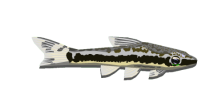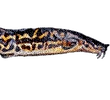Got milk?
Got milk?
Let me tell you something strange: Some months ago I bought a Acanthodoras sp (don't know if its spinossissimus or cataphractus, it was sold as a A.spinossissimus, but it looks more cataphractus-ish to me anyway).
The guy at the LFS says: Wanna see something weird? And puts his hand down in the tank holding the Acanthodoras catfish and picks it up (not out of the water, just out from its cave). Then, with the fish in his hand, turns it upside down in his palm and the fish starts to squirt out a white milky fluid from its gills, quite a lot too, so it clouds the water surrounding it. This goes on for a couple of seconds until the guy releases it from his hand, the catfish turns over on its right side and swims away for shelter. Leaving behind a white-grey cloud in the tank.
Like I said earlier, I bought one of these catfishes. But I haven't been handling it since i bought it and I haven't seen that behaviour in my tank either. (It's the biggest fish in the tank so maybe he doesn't feel threatened enough by anything to start squirting out this fluid (that's just me guessing it is some kind of defense mechanism))
Have anyone of you seen this happen?
The guy at the LFS says: Wanna see something weird? And puts his hand down in the tank holding the Acanthodoras catfish and picks it up (not out of the water, just out from its cave). Then, with the fish in his hand, turns it upside down in his palm and the fish starts to squirt out a white milky fluid from its gills, quite a lot too, so it clouds the water surrounding it. This goes on for a couple of seconds until the guy releases it from his hand, the catfish turns over on its right side and swims away for shelter. Leaving behind a white-grey cloud in the tank.
Like I said earlier, I bought one of these catfishes. But I haven't been handling it since i bought it and I haven't seen that behaviour in my tank either. (It's the biggest fish in the tank so maybe he doesn't feel threatened enough by anything to start squirting out this fluid (that's just me guessing it is some kind of defense mechanism))
Have anyone of you seen this happen?
- Silurus
- Posts: 12461
- Joined: 31 Dec 2002, 11:35
- I've donated: $12.00!
- My articles: 55
- My images: 896
- My catfish: 1
- My cats species list: 90 (i:1, k:0)
- Spotted: 428
- Location 1: Singapore
- Location 2: Moderator Emeritus
This is a well-documented defense mechanism for doradids. The milky-white secretion actually comes from the axillary pore (or porus pectoralis) located at the base of the pectoral spine.
Several other catfishes also produce secretions from the pore (pangasiids, some akysids). In the case of akysids, this is known to be toxic to other fishes.
Several other catfishes also produce secretions from the pore (pangasiids, some akysids). In the case of akysids, this is known to be toxic to other fishes.

- Silurus
- Posts: 12461
- Joined: 31 Dec 2002, 11:35
- I've donated: $12.00!
- My articles: 55
- My images: 896
- My catfish: 1
- My cats species list: 90 (i:1, k:0)
- Spotted: 428
- Location 1: Singapore
- Location 2: Moderator Emeritus
- Sid Guppy
- Posts: 757
- Joined: 31 Dec 2002, 15:36
- Location 1: Brabant, the Netherlands
- Interests: Catfish, Tanganyikan fish, Rock'n'roll, Fantasy
Yup
That salesman surely must have been experienced, or very, very lucky.
I've been on the wrong pectoral side of a spiny once (it was indeed a A spinosissimus), and afterwards, it was prime band-aid time; I bled like a wounded ox.....



That salesman surely must have been experienced, or very, very lucky.
I've been on the wrong pectoral side of a spiny once (it was indeed a A spinosissimus), and afterwards, it was prime band-aid time; I bled like a wounded ox.....
Plan B should not automatically be twice as much explosives as Plan A




